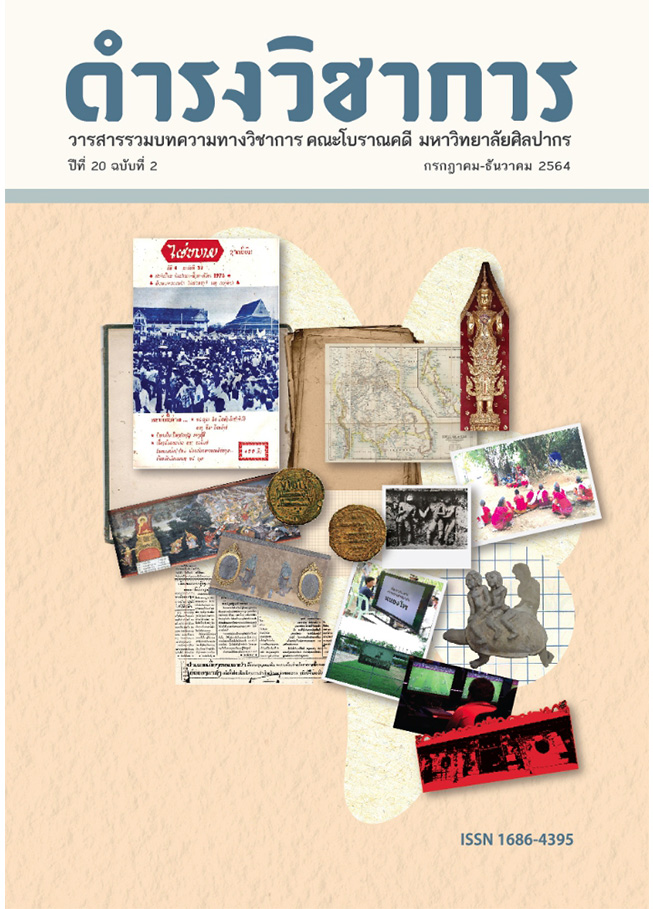Pen and Palisade: The Phai Nam Magazine and the Sociology of Modern Lao Literature
Keywords:
Phai Nam magazine, modern Lao literature, sociology of literature, literary field, literature and cultural capitalAbstract
Through the lens of sociology of literature, this essay examines the roles of the Phai Nam magazine, published in the 1970s, in the production and consumption of modern Lao literature. Pierre Bourdieu’s concept of the “literary field” particularly illuminates complex interactions between the authors of Phai Nam and other groups of writers during the time of Cold War ideological conflicts as a competition for cultural capital that would, in turn, affirm each group’s status in modern Lao literary circles. The Phai Nam magazine’s self-positioning as the “palisade” of Lao society contributes to its prestigious status for its ability to combine the notion of cultural roots, circulated widely during the nation-making period, with the production of satirical fiction and critical social commentary. The publications of these socially and politically engaged works in the context of struggles against Western imperialism allowed Phai Nam authors to play significant roles during the transition from the Royal Lao Government to the socialist regime, confirming the significance of the Phai Nam magazine in Lao national history as well as literary history.
References
ภาษาไทย
ชนิดา เสงี่ยมไพศาลสุข (ผู้แปล), 2550. เศรษฐกิจของทรัพย์สินเชิงสัญลักษณ์. กรุงเทพฯ: คบไฟ.
ชัยรัตน์ พลมุข, 2558. “นิทานเก่าในโลกใหม่: วรรณกรรมลาวสมัยอาณานิคมฝรั่งเศสกับขบวนการเคลื่อนไหวทางวัฒนธรรม.” ใน สร้อยมาศ รุ่งมณี (บรรณาธิการ), ยาดแย่งการพัฒนาและความทันสมัยในลาว (หน้า 209-242). เชียงใหม่: ศูนย์อาเซียนศึกษา มหาวิทยาลัยเชียงใหม่.
มนธิรา ราโท, 2553. วรรณกรรมเวียดนามหลังปี ค.ศ. 1975: พลวัตและการเปลี่ยนแปลง. กรุงเทพฯ : สำนักพิมพ์แห่งจุฬาลงกรณ์มหาวิทยาลัย.
วิยะดา พรหมจิตต์, 2541. “พัฒนาการเรื่องสั้นลาว: ความสัมพันธ์กับสังคม.” วิทยานิพนธ์ปริญญาอักษรศาสตรมหาบัณฑิต จุฬาลงกรณ์มหาวิทยาลัย.
อุมมีสาลาม อุมาร, 2558. “พัฒนาการเรื่องสั้นลาว.” รูสมิแล 38 (2): 6-17.
ภาษาลาว
เกียงคำ (นามแฝง), 1972. “หนามไผ่.” ไผ่หนาม 1 (1): 2-4.
เกียงคำ 2 (นามแฝง), 1975. “หนามไผ่.” ไผ่หนาม 4 (37): 4-5.
ครูจันท์ (นามแฝง), 1975. “พาสา พาเสีย.” ไผ่หนาม 4 (37): 21-22.
ดอกเกด (นามแฝง), 1973. “บ่เป็นหยัง.” ไผ่หนาม 2 [[----------(10): 24-25.
ด. วีระวงส์ (นามแฝง), 1975. “12 ตุลา วันมหาชัย.” ไผ่หนาม 4 (38): 8-9.
ท่ง อุบมง (นามแฝง), 1972. “เหลือเชื่อ.” ไผ่หนาม 1 (2): 11-15.
บ่อแสงคำ วงดาลา และคณะ, 2008. วันนะคะดีลาว. เวียงจัน: สำนักพิมและจำหน่ายปึ้มแห่งลัด.
ปาไน (นามแฝง), 1972. “กว่านี้มีอีกบ่?” ไผ่หนาม 1 (2): 56-58.
พะทูทอง (นามแฝง), 1973. “น้ำตาจิกกิ.” ไผ่หนาม 2 (13): 62-68.
ม. มาลาวัลย์ (นามแฝง). 1964. “วันนาผู่อาพับ.” แผ่นดินลาว (ฉบับพิเศษ): 8-9.
---------------, 1964. “กำแพงสังคม.” แผ่นดินลาว (ฉบับพิเศษ): 23.
ลาวสิวิไล (นามแฝง), 1963. “วิจารการเมืองในลาว.” ชาตลาว 1 (4): 4-6.
แลง พูผาเงิน (นามแฝง), 1972. “แดงจัน.” ไผ่หนาม 1 (1): 5-9.
แลง พูผาเงิน (นามแฝง), 1975. “ตายอย่างหมา.” ไผ่หนาม 4 (38): 5-6, 30-31, 41.
สมจิน งิน, 1953. “บันนาทิกานถแลง.” วันคะดีสาน 1 (1): 3-6.
สมพาวัน อินทะวง. “Un homme est mort.” มิตสอน 3 (10): 10.
ส. วีระวงส์ (นามแฝง), 1972. “เมืองไผ่หนาม.” ไผ่หนาม 1 (1): 49-52.
สิลา วีระวงส์, 1975. “วันที่ 12 ตุลา ปี 1945 30 ปีหลังเรายังจำได้.” ไผ่หนาม 4 (38): 18-19, 39.
อินแปง สุริยะไท, 1965. “บันนาทิการถแลง.” แผ่นดินลาว (ฉบับพิเศษ): 3, 39.
อุทิน บุนยาวง, 1988. “คนงาม.” วันนะสิน 9 (98): 11-12.
ภาษาอังกฤษ
Bourdieu P., 1993. The field of cultural production. New York: Columbia University Press.
English J., 2010. “Everywhere and nowhere: The sociology of literature after ‘the sociology of literature’.” New Literary History 41 (2): v-xxiii.
Ivarsson S., 2008. Creating Laos: The making of a Lao Space between Indochina and Siam, 1860-1945. Copenhagen: NIAS Press.
Koret P., 2000. “Books of search: The invention of traditional Lao literature as a subject of study.” In D. Smyth (Ed.), The canon in Southeast Asian literatures: Literatures of Burma, Cambodia, Indonesia, Laos, Malaysia, the Philippines, Thailand and Vietnam. Richmond: Curzon Press.
----------, 2009. “The short story and contemporary Lao literature.” In T. Yamada (Ed.), Modern short fiction of Southeast Asia: A literary history. Ann Arbor, Michigan: Association for Asian Studies.
Downloads
Published
Issue
Section
License
Copyright (c) 2021 Damrong Journal of The Faculty of Archaeology Silpakorn University

This work is licensed under a Creative Commons Attribution-NonCommercial-NoDerivatives 4.0 International License.
บทความนี้เป็นผลงานของข้าพเจ้าแต่เพียงผู้เดียว และ/หรือเป็นผลงานของข้าพเจ้าและผู้ร่วมงาน ตามชื่อที่ระบุในบทความจริง และเป็นผลงานที่มิได้ถูกนำเสนอหรือตีพิมพ์ที่ใดมาก่อน


